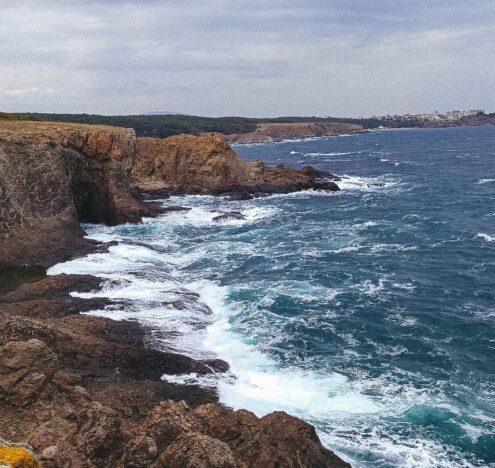As I sit happily eating my Banann Peze (Plantanos), Griot (Chicharon), and my plate of rice and beans (Diri Kole), I can’t stop thinking about how many times during my travels through Latin America I have experienced the same dish under a different name. The subtle differences lie only in the seasoning and the methods of cooking.
The culinary landscape of Haiti, much like its Latin American counterparts, is a melting pot of Indigenous, African, and European elements, creating a food culture that is simultaneously unique and familiar within the Latin American gastronomic scene. The Taino influence, for instance, is evident in the use of specific cooking techniques and staple ingredients like cassava and corn. We also find the African legacy in the robust, spicy flavors and the use of ingredients like okra and plantains, resonating with the food found in other countries with notable African diasporic populations like Brazil and Colombia. Meanwhile, the European influence manifests in the sophistication of certain dishes, mirroring the haute cuisine that has also permeated Latin American coastal cities.
To set the stage for this discussion, I believe having a mise en context of Latin America and its composition is essential. Historically and geographically, Latin America refers to a set of nations in the regions of North, Central, South America and the Caribbean. Michel Chevalier coined the term in the 1850s to distinguish the Latin-based language-speaking peoples of the Americas from the Anglo-Saxon populations. Haiti, with its Francophone background, is a bit of an outlier in this dichotomy. Despite being coined by a Frenchman, the “Latin” roots implied in the Latin America terminology referred primarily to Hispanic and Lusophone countries.
Haiti has long struggled to fit in the Latin American conversation despite its shared histories and heritage, and even sharing the island of Hispaniola with the Dominican Republic. The country has struggled to create allies and support regionally, mainly due to linguistic differences and regional politics. The tainted Haitian exceptionalism of the media and the world has also cast Haiti into a corner of shame, overlooking the historical contribution of people and arms Haiti dedicated to the liberation of the region. Haiti, along with its cuisine, seems to be banished under an umbrella image of poverty and catastrophe and refused acknowledgment of its belonging to Latin America.
There’s no better place to reconcile and appreciate shared experiences than the kitchen, so let’s start there.
Ingredient List
At the heart of every culinary masterpiece is a carefully curated list of ingredients, each serving a purpose to achieve the desired gastronomic experience. These ingredients are more than just physical items; they represent the history and culture that shape a cuisine’s identity. In this metaphorical pantry, history is our stock of ingredients. In Latin American cuisine, the shelf is laden with a ½ cup of Taino heritage, a robust ¼ cup of African vibrancy, and a ½ cup of European colonial influence. This blend forms the foundation of many dishes revered in Latin America.
In Haiti, this ingredient list is adjusted — perhaps a bit more Taino heritage here, a pinch less European influence there — yet the essence of the final dish remains unmistakably part of the grander Latin American culinary tradition. The variances in Haitian cuisine offer a nuanced taste profile that echoes the broader Latin American palate, creating a rich tapestry of distinct and harmonious flavors.
Let’s bite into a personal favorite, the variation of Chicharron and Griot. Chicharron is a heritage of the Spanish settlement. Traditionally, preparing the chicharron involves cooking pieces of fatty pork until they are very crisp. The name derives from the word achicharrar, or chicharrar, meaning to expose something to heat until it is charred or toasted. As there are different types of Chicharron across different countries and regions, chicharron norteño will serve as our example. The norteño consists primarily of generous chunks of pork belly, boiled and then crisped in their own fat, an old standard and forgotten method of traditionally making Griot.
Griot, in contrast, maintains a unique Haitian identity through specific marinating techniques and native spices that involve the piquancy of scotch bonnet peppers and the tang of bitter orange — a blend reminiscent of the African and Taino heritage. The cooking process transforms the marinated pork into succulent pieces with a crisp exterior. The communal aspect of enjoying Griot is often accompanied by Pikliz, a spicy pickled vegetable relish, an addition not commonly found within the rest of the region. While the methodology might differ, it is fair to argue that it is primarily the same dish as chicharron. Both share the fundamental concept of deep-fried pork meat, celebrated across Latin America.
This theme of culinary parallels continues with dishes such as gallo pinto in Costa Rica, akin to Haiti’s Diri ak pwa rouj, tracing their lineage to African roots. The Doukouno, a staple in Haiti’s Artibonite region, presents a cornmeal dish reminiscent of Taino traditions, analogous to Latin American tamales. Yet, the distinctive Haitian preference to enjoy Doukouno sweetened with honey or cane syrup rather than the savory variations in other parts of the region highlights a cultural divergence in the palate, illustrating the subtle, however significant differences defining the gastronomic profile of the region.
The parallels between the dishes are forged in the shared history of food and culture. The historical voyage of ingredients between the “Old World” and the “New World” played a pivotal role in shaping the culinary landscapes of Haiti and Latin America. The colonial era’s trade routes acted as culinary conduits, introducing staples such as wheat, rice, and cattle alongside sugarcane and coffee, and forging new economic and social realities. These exchanges diversified diets and created a shared gastronomic language, melding distant cultures on a plate. Colonies were geographically disbursed but shared similar climates and base ingredients such as corn, rice, and beans. Additionally, the plantation economy greatly influenced local food production techniques, as enslaved Africans brought their culinary traditions, adapting and blending them with Indigenous and European influences.
For a long time, Haitian cuisine has struggled to establish itself within the culinary world. Its slight nuances in language and cooking methods have made Haitian cuisine hard to define and classify. The names of the dishes are different, and the cooking methods are different solely because our historical pantry held other ingredients.
Building Flavors
The sizzle, a mouthwatering sound in cooking, starts the layering of flavors essential to Latin American culinary technique. The frying of sofrito is akin to Haiti’s Epis, a blend of herbs with culinary umami that transforms any dish. Sofrito is originally from Catalonia in Spain, stemming from sofregit, a Catalan word meaning lightly fired or sautéed. The dish has made its way to the Caribbean with varied ingredients and methods across the region. Traditionally, the sofrito is composed of cilantro, peppers, and garlic turned into a paste. In Haiti, however, a slight variation is noticed in the use of green onion, parsley, and scotch bonnet pepper.
At a grand feast representing the diverse culinary landscape of Latin America, including Haiti, the dishes would speak a language of shared heritage more than disparate histories.
We will remember Haiti was also a Spanish colony from 1492, before being sold to the French in 1697. The Spanish legacy laid the foundation for a rich fusion of culinary techniques and ingredients. Hispaniola, or “Little Spain,” preserved the gastronomic heritage of its original European settlers. Sofrito and Epis epitomize the synthesis of historical influences and regional adaptations.
However, it is understandable why Haiti isn’t listed in search results for top Latin American cuisine. The French influence meshed in the culinary facet of the half-island has created a cuisine that separated itself from the traditional Spanish influence. In Haitian gastronomy, you will find techniques more reminiscent of French culinary methods, like petit fours, and paté, a phyllo-dough pastry similar to pastelitos but with meat or fish. There are also a lot more accents on gratinées, a cheese-based dish prepared in the oven, along with different variations of rice dishes and pastries like cakes and bread. Yet, Haitian cuisine also celebrates popular Latin American dishes such as ceviche, empanadas (locally known as Pate Kode), and the beloved tostones.
The ingredient list illustrates a collective narrative of exploration, colonization, and blending disparate worlds. As we trace the evolution of these flavor bases, we see a story of adaptation and resilience. This culinary dialogue opens for the discussion of understanding Haiti and its place or lack thereof in the rest of the Latin American spectrum.
Setting the Table
The similarities demonstrated in the shared history and food make it hard to understand why Haiti continues to linger in the shadows. Is it the stereotypes about Haiti that haunts its inclusion? Haiti’s contribution to the world, and in this case to Latin America, in terms of gastronomy, history, music, and literature, is often overshadowed by the toxic narratives about the island. But it could be otherwise.
At a grand feast representing the diverse culinary landscape of Latin America, including Haiti, the dishes would speak a language of shared heritage more than disparate histories. With its subtle distinctions in preparation, the Haitian contribution would not stand apart but rather complement the regional tableau, accentuating a rich, collective narrative. The essence of our gastronomy amongst other things is a testament to a shared past — a past that weaves through the fabric of each country’s identity. With its vibrant flavors and historical depth, Haiti should reclaim its place at the diverse and inclusive table of Latin America.





















